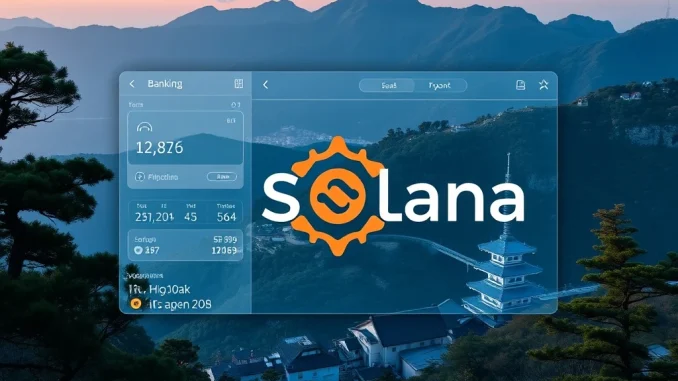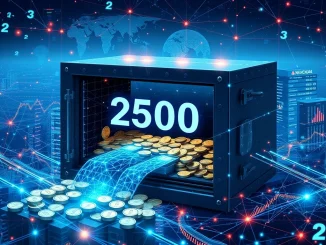
Get ready for a fascinating development from the Land of the Rising Sun! Japan stablecoin innovation is taking a significant leap forward as Minna Bank, the nation’s first digital-only neobank, dives deep into the world of stablecoins and Web3 technology. This pilot project, conducted on the high-performance Solana blockchain, signals a potential transformation in how Japanese users might interact with digital assets and financial services in the near future.
What’s Happening with Minna Bank Solana Pilot?
Minna Bank, known for its forward-thinking approach to banking, isn’t just dipping its toes in; it’s launching a dedicated pilot program to seriously explore the practical applications of stablecoins and Web3 wallets. This isn’t a solo venture, either. The bank has teamed up with some major players in the digital asset space to make this happen:
- Fireblocks: A leading digital asset infrastructure provider, crucial for secure handling of digital assets. Their expertise is vital for institutional-grade crypto operations.
- Solana Japan: The local arm supporting the Solana ecosystem, providing the blockchain foundation for the pilot. Solana’s speed and low transaction costs make it an attractive platform for potential high-volume use cases.
- TIS: A technology solutions company that likely brings integration and system development expertise to the project.
The core objectives of this collaboration center around understanding the feasibility and benefits of:
- Issuing and managing stablecoins on the Solana blockchain.
- Developing and utilizing digital wallets that offer enhanced, user-friendly financial experiences powered by Web3 concepts.
This initiative could pave the way for Minna Bank, and potentially other financial institutions in Japan, to offer services that bridge traditional finance with the burgeoning world of decentralized technology.
Exploring the Potential of a Solana Web3 Wallet
One of the exciting aspects of this pilot is the focus on the Solana Web3 wallet. What exactly does a Web3 wallet offer compared to traditional banking apps or even standard crypto wallets? A Web3 wallet is designed to interact directly with decentralized applications (dApps) and services on a blockchain. For a neobank like Minna Bank, integrating such a wallet could unlock several possibilities:
- Seamless Access to DeFi (Decentralized Finance): While the pilot’s immediate focus is stablecoins, a Web3 wallet could eventually allow users to interact with lending protocols, decentralized exchanges, and other DeFi services built on Solana.
- Enhanced User Control: Depending on the implementation, users might have more direct control over their digital assets within the bank’s ecosystem.
- New Service Offerings: Imagine a bank account linked to a Web3 wallet that allows instant, low-cost stablecoin transfers, or even participation in tokenized loyalty programs.
- Interoperability: A Solana-based wallet could potentially interact with other applications and services within the Solana ecosystem, expanding the utility beyond just basic banking.
The pilot will likely scrutinize the user experience, security implications, and technical challenges of integrating such a wallet into a regulated banking environment.
What Does This Mean for Japanese Neobank Crypto Adoption?
Minna Bank’s move is a significant indicator for the broader landscape of Japanese neobank crypto integration. As Japan’s first neobank, Minna Bank often sets a precedent for digital banking innovation in the country. Their serious exploration of stablecoins and Web3 suggests that these technologies are moving beyond niche crypto communities and into the realm of mainstream financial services. This pilot could provide valuable insights for regulators and other financial institutions, potentially accelerating the adoption of digital assets in Japan’s financial sector. It highlights a proactive approach to understanding and potentially leveraging blockchain technology rather than just observing it from the sidelines.
The Role of Fireblocks Japan in the Pilot
The involvement of Fireblocks Japan is particularly noteworthy. Fireblocks is a trusted name in providing secure digital asset infrastructure for institutions. Their platform offers robust security measures, including multi-party computation (MPC) technology, which is essential for banks handling customer funds and complying with stringent regulations. Their participation indicates that Minna Bank is prioritizing security and compliance from the outset. Fireblocks’ expertise will be critical in ensuring that the pilot’s technical foundation is secure, reliable, and meets the high standards required for financial services, especially in a regulated market like Japan.
Why Stablecoins on Solana?
The choice of Solana for exploring stablecoins is strategic. Solana is known for its high throughput (processing many transactions per second) and low transaction costs, which are crucial for payment systems and frequent transfers. Stablecoins, designed to maintain a stable value (often pegged to fiat currency like the Japanese Yen or US Dollar), are ideal for payments, remittances, and value transfer without the volatility of cryptocurrencies like Bitcoin or Ethereum. Running stablecoin operations on an efficient blockchain like Solana could potentially lead to faster and cheaper transactions compared to traditional methods or less scalable blockchains.
Potential Benefits and Challenges
This pilot holds significant potential benefits but also comes with challenges:
Potential Benefits:
- Faster and cheaper cross-border payments using stablecoins.
- New financial products and services built on Web3 rails.
- Increased financial inclusion and accessibility through digital wallets.
- Enhanced transparency for certain types of transactions on the blockchain.
- Positioning Minna Bank as a leader in digital finance innovation in Japan.
Challenges:
- Navigating Japan’s evolving regulatory landscape for stablecoins and crypto assets.
- Ensuring the security and stability of the technology stack.
- Educating users on how to use Web3 wallets and stablecoins safely.
- Integrating blockchain systems with existing core banking infrastructure.
- Managing potential risks associated with smart contracts and decentralized protocols.
Conclusion: A Glimpse into Japan’s Digital Financial Future
Minna Bank’s pilot project with Fireblocks, Solana Japan, and TIS is more than just a technical experiment; it’s a crucial step towards understanding how blockchain, stablecoins, and Web3 wallets can integrate with mainstream banking in Japan. This initiative could serve as a blueprint for future digital financial services, potentially offering users faster, cheaper, and more innovative ways to manage their money. As the pilot progresses, the insights gained will be invaluable for both the bank and the broader Japanese financial ecosystem, signaling a potential era of exciting digital transformation.



